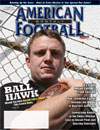Article CategoriesAFM Magazine
|
The Strength Report - How to Prepare Your Athletes for Collegiate and NFL Weight Programsby: Joe Kenn MA, CSCS, SCCCDirector of Athlete Development – Football, University of Louisville © More from this issue Preparing Your Athletes for Collegiate Strength Programs By Joe Kenn MA, CSCS, SCCC In an era where physical fitness is at an all time low, it is imperative that coaches at the high school level understand they are not getting the same type of athletes coaches worked with decades before. With the de-emphasis of general physical education at the elementary and middle school levels we are seeing an alarming rate of youth obesity and lack of general “play”. The roles of unorganized after school play or pickup games where the kids are active are rarely seen in most communities. Almost all sport is played in some type of organized fashion and specialization of sport has become commonplace.
|
|
|||||||
| HOME |
MAGAZINE |
SUBSCRIBE | ONLINE COLUMNISTS | COACHING VIDEOS |
Copyright 2025, AmericanFootballMonthly.com
All Rights Reserved





